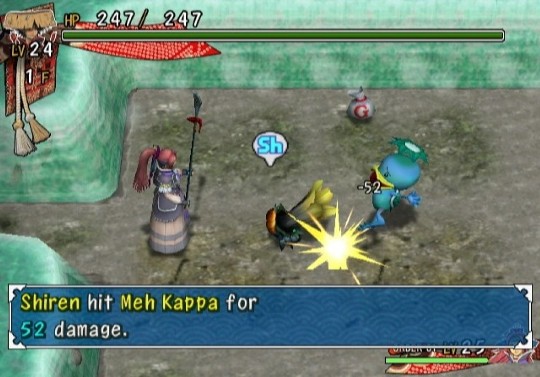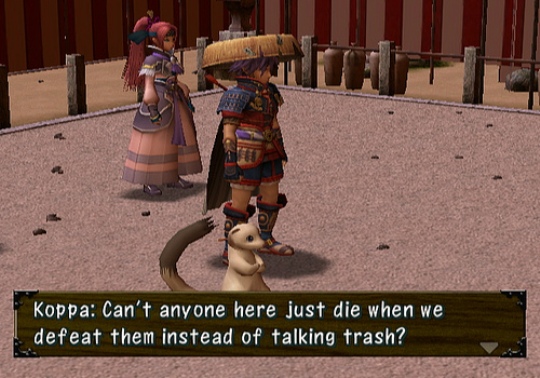Shiren the Wanderer starts out as a basic game in a lot of regards, but develops quickly into what can be safely be called an enjoyable dungeon crawler with enough JRPG elements to differentiate it from other games in the genre, but not so many that it ceases to be a true roguelike.
For those unfamiliar with the roguelike (dungeon crawler) genre, gameplay is based on trolling through randomly generated levels of dungeons, gaining experience and better equipment throughout. Shiren the Wanderer has all of that, with a solid 30+ hours worth of dungeon exploration, tons of weapons and items to collect and upgrade, and a slew of interesting boss battles along the way. Movement throughout the dungeons can either be as simple or as tactically complicated as you want; the settings can be changed to allow free-flowing movement through each character’s turn, or “Full Control” mode can be activated to allow for a turn-by-turn controllable breakdown. This system works out really well within the context of this game, as it allows players to almost hack and slash through some easier enemies, and then spend their time thinking and planning when fighting higher-level creatures.

Shiren the Wanderer for the Wii in the US is actually a port of the Japanese version of the game titled Shiren the Wanderer 3. And apparently, sales for the game in Japan were lackluster compared to expected sales, the cause being that the hardcore Japanese gamer market was turned off by the game’s shift towards an easier, more forgiving player experience. However, the option to choose an easy feature truly makes the game more accessible to a wider audience; especially the kind of audience that plays RPGs but would like to give dungeon crawlers a try. By choosing the easy setting in the game, players forego the traditional extreme difficulty of the series in favor of maintaining their level-up progress and inventory upon death. While some may criticize this port for “going soft” on players, it does allow for less frustrating play. And, for those gamers looking for the true roguelike experience, the game offers the option of playing in the Portal dungeon, which effectively erases the character’s level-up progress and allows for a one-shot all the way through.
As for the JRPG elements of the game, Shiren the Wanderer also sports a full-fledged story that follows ronin warrior Shiren, his cheeky ferret sidekick Koppa, their sensei (called Sensei), and a mysterious she-warrior Asuka. The characters can visit towns and other non-dungeon locations where they can trade, bank, and store their belongings, but all of this is clearly peripheral to the leveling up and combat, though it affords a nice break from the action. The story begins with a search for the great treasure supposedly inside Karakuri Mansion, which involves an ancient prophecy, and princesses, etc. The story isn’t the star of the show, though parts of it play out in some good-looking cinematic movies, but it moves along the game progression enough to, once again, bridge the gap between hardcore roguelike elements and RPG elements. However, players hoping to simply experience the story by quickly jaunting through the dungeons will be disappointed, as the real core of the game lies in the dungeon exploration. On the plus side for story elements, players are forced to make decisions throughout the game that directly affect what missions they will play and how they play them, though the diverging paths converge quickly to remain consistent to the overarching story. It is nice to see that kind of evolution, though, in a genre so rooted in tradition.

Presentation is another point where Shiren the Wanderer fails to impress, with Gamecube-level graphics and fitting but mediocre sound design. Of course, because the title was released on the Wii, it didn’t have the chance to go HD, but even given that barrier, the game still underperforms graphically. Attempts at giving the game a greater cinematic quality unfortunately fall flat due to the subpar graphics and character animations, and sometimes very lengthy segments of conversation make for a lot of reading, as the game has no voice acting. In a throwback kind of way, these elements are refreshing, but they mostly come off as a hindrance to the rest of the game. And the control scheme, while effective and not overly complicated, doesn’t make any use of the Wii’s best asset, the motion controls. The game can be mapped to a wide array of Wii controller configurations, but none are any more impressive or more useful than the last.
So the final word on Shiren the Wanderer is, really, that it depends what you’re looking for. Traditional dungeon crawler fans will be pleased by the robust dungeons and combat options that truly make up the core of this game. But while the addition of JRPG ideas and mechanics diversifies player experience slightly, Shiren the Wanderer is still a roguelike at heart, which it honors exceedingly well, perhaps at the expense of other gameplay elements.

















